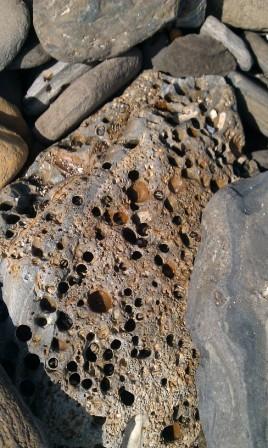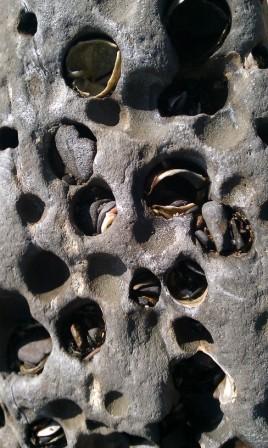
Holey rock from piddock clams
Walking along the beach in Southern California, you might come across holey rocks and wonder, who or what in the world made all those holes? Perhaps the result of some alien testing to determine what planet Earth is all about? Or someone with way too much time on their hands? Not exactly…
The answer is: piddock clams!
Piddock clams are a type of clam that can bore into rocks. This happens to be an excellent strategy if you need to protect yourself from pounding waves. Instead of living with the constant threat of being washed away, it’s much safer and secure to create a permanent home in a rock.
Like many other marine animals, piddock clams start their lives as plankton, floating along at the mercy of ocean currents. While they are floating, piddock clams start looking for a place to settle by tasting and smelling the water to find fellow piddock clams that have already found a great rock home.

Rock with shells of piddock clams
Once a piddock clam finds a suitable rock community of like-minded clams, it grasps the rock’s surface with a broad foot and starts to grow a shell. The shell has ridges or tooth-like serrations the piddock clam uses to burrow into the rock by twisting back and forth.
Piddock clams continue boring into the rock until they are fully grown. Then they secrete shell material over their foot and officially take up residence. But how do you eat if you can’t leave your rock home?
Luckily, piddock clams have two siphons. To eat, piddock clams pump in water and filter food from the water with one siphon. Then they pump out waste with the other siphon. This all takes place as they are snugly situated in a rock.
And there you have it! The reason you may find holey rocks.
This writer is fantastic!! The article was most informative and answered a deep mystery long held by entire coastlines of the world and one guy in Ecuador named Phil. Well done!!
Utterly fascinating. Love it.
Thanks for the wonderfully interesting article!
Impressive! I used this simple explanation in pre-school classes for many years. I got the info with great difficulty as the internet was still in the fascinating future.
I have always wondered what causes the holes, thanks for sharing. I have a very large holey rock and it looks like it had been used as an anchor at one time. Very interesting to see. I’m looking for someone who might be interested in buying it. Any suggestions?
Hi Patricia, Sounds like you have a cool rock! I’m not sure who would be interested in buying that type of thing, sorry! Maybe try searching rock collectors online?
I live in Kansas. Where i live is a LOT of these rocks. How could this be in the central plains if the country?
There used to be an inland ocean in the central USA millions of years ago.
So they live there happily ever after. Then what? If paddock clams are angel wings they must leave the rocks. True or false?
My husband and I found a beach (U.P. Of Mich.) and there were rocks like this every size imaginable. We picked up the ones we could handle and brought them back home to share with our children. i